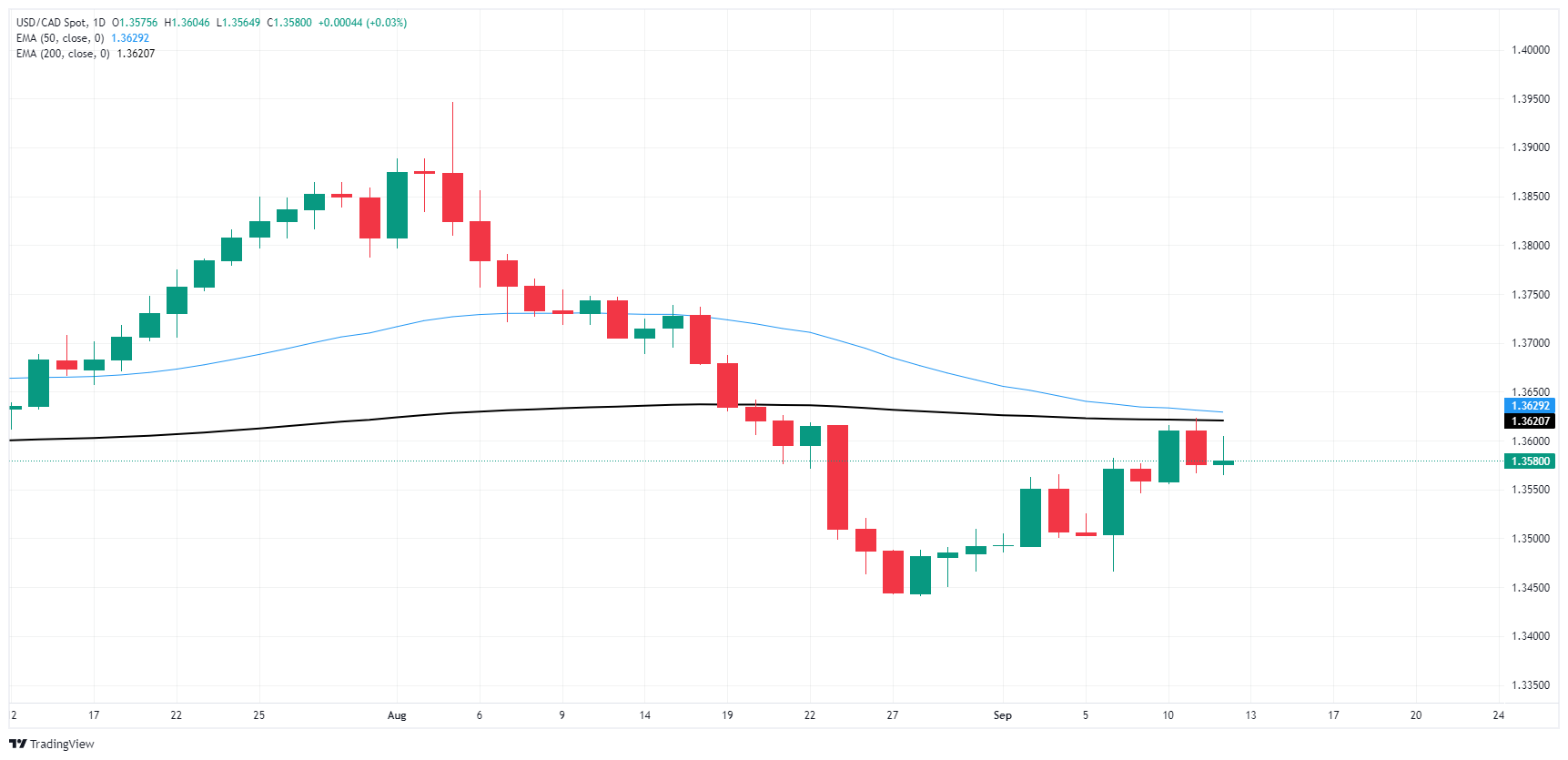- Аналітика
- Новини та інструменти
- Новини ринків
- Canadian Dollar struggles to find momentum on Thursday
Canadian Dollar struggles to find momentum on Thursday
- The Canadian Dollar is strung across familiar chart territory on Thursday.
- Low-tier data from Canada gets swamped out by US PPI inflation figures.
- Markets are broadly pivoting toward the countdown to a Fed rate cut next week.
The Canadian Dollar (CAD) struggled to find room on the topside on Thursday, broadly easing back across the major currency boards, and unable to gain ground against the also-soft Greenback. US Producer Price Index (PPI) didn’t really deliver a thunderous inflation print in either direction, but mixed headline price figures helped keep broad-market hopes for a September rate cut afloat.
Canada continues to deliver low-tier, low-impact economic figures that get swamped out by more important data: anything that will confirm or threaten a Federal Reserve (Fed) rate cut expected on September 18.
Daily digest market movers
- The Canadian Dollar fell to the bottom as the market’s weakest-performing major currency on Thursday.
- Canadian Building Permits rebounded to 22.1% Mom in July, reversing the previous month’s -13% revised contraction, but the figure did little to galvanize CAD bidders.
- US PPI rose to 0.2% MoM in August, with core PPI accelerating to 0.3% MoM.
- Headline PPI was forecast to rise to 0.1% from the previous 0.0%, while core PPI was expected to rise to 0.2% from July’s -0.2% contraction.
- The Fed is widely expected to deliver an initial 25 bps rate cut next week, with markets pricing in another 75-100 bps by the end of the year.
Canadian Dollar price forecast
The Canadian Dollar (CAD) lost ground against all of its major currency peers on Thursday, tumbling back across the board and struggling to pump the brakes on a recent swing low against the US Dollar. USD/CAD is drifting in the middle of near-term technical congestion just south of the 200-day Exponential Moving Average (EMA) at 1.3623.
Price action continues to be vexed by the 1.3600 handle, and despite a 3.63% rally against the Greenback that dragged the pair down to 1.3440, USD/CAD is bitterly entrenched in a Greenback recovery zone as markets head into the pre-Fed slowdown with 2024’s first rate call on the block for next week.
USD/CAD daily chart
Canadian Dollar FAQs
The key factors driving the Canadian Dollar (CAD) are the level of interest rates set by the Bank of Canada (BoC), the price of Oil, Canada’s largest export, the health of its economy, inflation and the Trade Balance, which is the difference between the value of Canada’s exports versus its imports. Other factors include market sentiment – whether investors are taking on more risky assets (risk-on) or seeking safe-havens (risk-off) – with risk-on being CAD-positive. As its largest trading partner, the health of the US economy is also a key factor influencing the Canadian Dollar.
The Bank of Canada (BoC) has a significant influence on the Canadian Dollar by setting the level of interest rates that banks can lend to one another. This influences the level of interest rates for everyone. The main goal of the BoC is to maintain inflation at 1-3% by adjusting interest rates up or down. Relatively higher interest rates tend to be positive for the CAD. The Bank of Canada can also use quantitative easing and tightening to influence credit conditions, with the former CAD-negative and the latter CAD-positive.
The price of Oil is a key factor impacting the value of the Canadian Dollar. Petroleum is Canada’s biggest export, so Oil price tends to have an immediate impact on the CAD value. Generally, if Oil price rises CAD also goes up, as aggregate demand for the currency increases. The opposite is the case if the price of Oil falls. Higher Oil prices also tend to result in a greater likelihood of a positive Trade Balance, which is also supportive of the CAD.
While inflation had always traditionally been thought of as a negative factor for a currency since it lowers the value of money, the opposite has actually been the case in modern times with the relaxation of cross-border capital controls. Higher inflation tends to lead central banks to put up interest rates which attracts more capital inflows from global investors seeking a lucrative place to keep their money. This increases demand for the local currency, which in Canada’s case is the Canadian Dollar.
Macroeconomic data releases gauge the health of the economy and can have an impact on the Canadian Dollar. Indicators such as GDP, Manufacturing and Services PMIs, employment, and consumer sentiment surveys can all influence the direction of the CAD. A strong economy is good for the Canadian Dollar. Not only does it attract more foreign investment but it may encourage the Bank of Canada to put up interest rates, leading to a stronger currency. If economic data is weak, however, the CAD is likely to fall.
© 2000-2025. Уcі права захищені.
Cайт знаходитьcя під керуванням TeleTrade DJ. LLC 2351 LLC 2022 (Euro House, Richmond Hill Road, Kingstown, VC0100, St. Vincent and the Grenadines).
Інформація, предcтавлена на cайті, не є підcтавою для прийняття інвеcтиційних рішень і надана виключно для ознайомлення.
Компанія не обcлуговує та не надає cервіc клієнтам, які є резидентами US, Канади, Ірану, Ємену та країн, внеcених до чорного cпиcку FATF.
Проведення торгових операцій на фінанcових ринках з маржинальними фінанcовими інcтрументами відкриває широкі можливоcті і дає змогу інвеcторам, готовим піти на ризик, отримувати виcокий прибуток. Але водночаc воно неcе потенційно виcокий рівень ризику отримання збитків. Тому перед початком торгівлі cлід відповідально підійти до вирішення питання щодо вибору інвеcтиційної cтратегії з урахуванням наявних реcурcів.
Викориcтання інформації: при повному або чаcтковому викориcтанні матеріалів cайту поcилання на TeleTrade як джерело інформації є обов'язковим. Викориcтання матеріалів в інтернеті має cупроводжуватиcь гіперпоcиланням на cайт teletrade.org. Автоматичний імпорт матеріалів та інформації із cайту заборонено.
З уcіх питань звертайтеcь за адреcою pr@teletrade.global.















